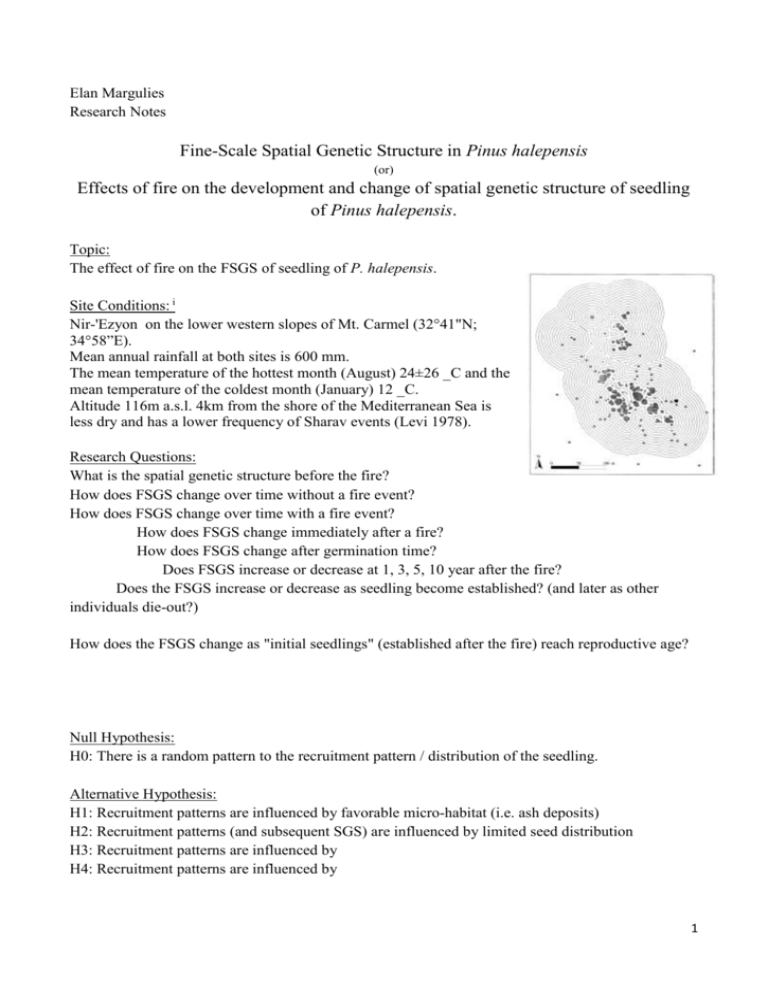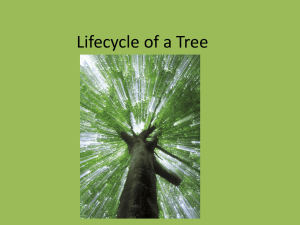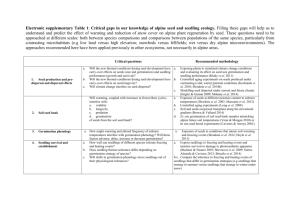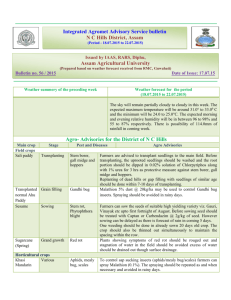Research Hypothesis - Seedling FSGS
advertisement

Elan Margulies Research Notes Fine-Scale Spatial Genetic Structure in Pinus halepensis (or) Effects of fire on the development and change of spatial genetic structure of seedling of Pinus halepensis. Topic: The effect of fire on the FSGS of seedling of P. halepensis. Site Conditions: i Nir-'Ezyon on the lower western slopes of Mt. Carmel (32°41"N; 34°58”E). Mean annual rainfall at both sites is 600 mm. The mean temperature of the hottest month (August) 24±26 _C and the mean temperature of the coldest month (January) 12 _C. Altitude 116m a.s.l. 4km from the shore of the Mediterranean Sea is less dry and has a lower frequency of Sharav events (Levi 1978). Research Questions: What is the spatial genetic structure before the fire? How does FSGS change over time without a fire event? How does FSGS change over time with a fire event? How does FSGS change immediately after a fire? How does FSGS change after germination time? Does FSGS increase or decrease at 1, 3, 5, 10 year after the fire? Does the FSGS increase or decrease as seedling become established? (and later as other individuals die-out?) How does the FSGS change as "initial seedlings" (established after the fire) reach reproductive age? Null Hypothesis: H0: There is a random pattern to the recruitment pattern / distribution of the seedling. Alternative Hypothesis: H1: Recruitment patterns are influenced by favorable micro-habitat (i.e. ash deposits) H2: Recruitment patterns (and subsequent SGS) are influenced by limited seed distribution H3: Recruitment patterns are influenced by H4: Recruitment patterns are influenced by 1 Conservation Implications: There is a growing interest in the study of longdistance dispersal because of its implicationsfor the fields of climate change (Clark et ii al. 1998a), invasions (Hengeveld 1994), and gene flow (Hamrick and Nason 1996). What is the recruitment density for the site and how does that change over time? iii *Are the established seedling there because of a genetic advantage? (Assumptions: The seeds/seedling are particularly suited to the microhabitat. There are a variety of seed sources that "seed" an area.) *Is the established pattern of seedlings due to seed distribution/dispersal from the parent plant? Advantages of canopy – shade during initial growth. To examine the effect of canopy area on dispersal and recruitment, we quantified the distances of seed trap stations and of juvenile pines from the nearest adult in two ways: (1) distance to the nearest central location of an adult tree, and (2) distance to the nearest canopy edge.iv We located 243 juvenile pines ($3 yr old) in our census of the study site in late May 1998. Of these, 80 individuals (hereafter saplings) had established during the study period: 34 belonged to the 1995 cohort, 26 to the 1994 cohort, and 20 to the 1993 cohort. Female cones of the first year after flowering (i.e., about two years before normal seed release) were found in one sapling, from the 1993 cohort. Not a single sapling was found under the canopy of any adult tree, and seedlings were rarely observed there. Saplings were observed mostly in two microhabitats: cracks and crevices in limestone rock slabs, and in abandoned olive grove terraces. These microhabitats showed no particular spatial pattern with respect to the adult trees. For all cohorts, sapling density was considerably lower at greater distances from adult trees, but the pattern near adult trees varied depending on the distance measure and, to some degree, the year (Fig. 3). When distance was measured to the nearest central location of an adult, the maximum density of the 1995 cohort was in the 5–10 m interval, whereas older cohorts peaked in the 10–15 m interval (Fig. 3a). When distance was measured to the nearest canopy edge, sapling density of the 1995 cohort peaked at the 0–5 m interval (0.0024 individuals/m2); for the older cohorts, it had two peaks in the 0–5 and 10–15 m intervals (Fig. 3b). Overall, sapling density in distance intervals within the near section (0.00083 6 0.00017 saplings/m2) was significantly higher than in those within the far section (0.00023 6 0.00003 saplings/m2; Mann-Whitney, U 5 12.0, P 5 0.002). v The proportion of seeds surviving to the sapling stage clearly increases with increasing distance from the trees in all cohorts, and for both methods of distance estimation (Fig. 4). In general, the probability of surviving three to five years (seed to sapling) was remarkably low, at most ;0.2%, and usually much lower. The highest estimated sapling : seed ratio within a distance interval was 1:533vi Eighty saplings (3–5 yr old) became established during the three years of the study, most within 15 m of the nearest canopy, some vii farther away, and none directly under the tree canopies. The estimated probability of seed survival to sapling stage increased significantly with viii increasing distance from adults, as predicted by the escape hypothesis. 2 Escape Hypothesis – more variation away from adults: We suggest that the low spatiotemporal variation near adults and the high variation far away act to intensify the effects of predation (by increasing the efficiency of predators near adults and reducing it far away) and competition (by increasing the intensity of seedling competition near adults and reducing it far away) in structuring ix the observed survivorship curve predicted by the escape hypothesis. Intro of dispersed seeds serves as a template for subsequent processes such as predation, germination, competition, and growthx Surviorship vs Recruitment curves Janzen (1970) and Connell (1971) proposed the escape hypothesis (Howe and Smallwood 1982), suggesting a positive slope of the survivorship curve, determined by the high mortality of progeny (seeds and seedlings) in the vicinity of adult plants, due to seed predators, parasites, xi pathogens, and seedling herbivores. Escape Hypothesis: The basic prediction of the escape hypothesis, that the probability of progeny survival increases with increasing distance from adult trees (Janzen 1970, Connell 1971, Howe and Smallwood 1982), is clearly supported by our findings. We also confirmed its basic assumption that seed density declines rapidly with increasing distance from adults. The prediction invokes distance- or density-responsive seed predation (Janzen 1970) and intraspecific competition with seedlings and adults (Harper 1977, Howe and Smallwood 1982) as the underlying mechanismsxii. recruitment should always be higher near adult because of the disproportionately high seed densities there.xiii Testing the escape hypothesis: Studies testing the escape hypothesis (Augspurger 1983, Clark and Clark 1984, Schupp 1988, Augspurger and Kitajima 1992, Condit et al. 1992) have examined the fate of seeds (or seedlings) at different densities and distances from adult plants.xiv Nathan_etal1999JEcol i Nathan_etal2001Ecology ii Nathan_etal2000Ecology iii Nathan_etal2000Ecology iv Nathan_etal2000Ecology v Nathan_etal2000Ecology vi Nathan_etal2000Ecology vii Nathan_etal2000Ecology viii Nathan_etal2000Ecology ix Nathan_etal2000Ecology x 3 Nathan_etal2000Ecology xi Nathan_etal2000Ecology xii Nathan_etal2000Ecology xiii Nathan_etal2000Ecology xiv 4









